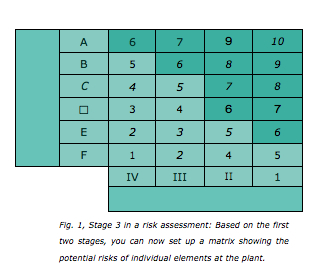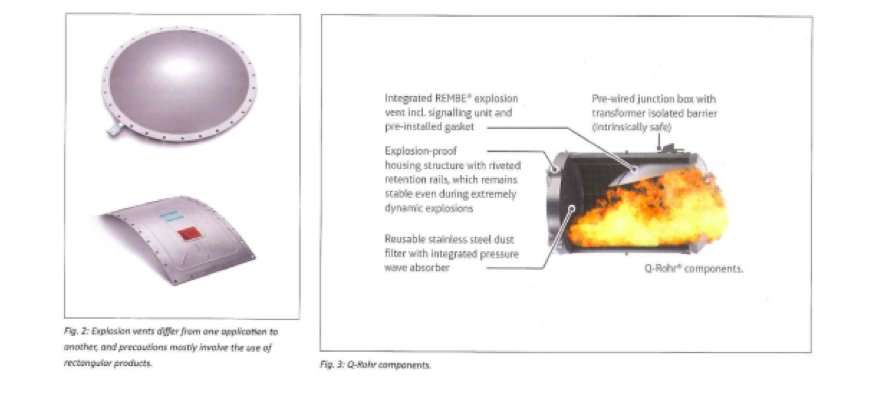

Summmary: Explosion Safety in Wood Processing Companies
Autora: Francesca Vincenzi, (Safety + Control, REMBE GmbH)
Woodworking processes account for around 28 % of industrial explosions making them the most dangerous in any industry in terms of frequency. In Issues 3/2016, 4/2016, 1/2017 we displayed in detail, what explosion safety in our industrial sector is about. Please find below a compressed summary of all articles.
Assessing the explosion hazardq
To decide whether and to what extent precautions are required, you would first conduct a systematic risk assessment. The first stage is to gauge the probability that an explosive atmosphere might be created and whetherthere are any potential sources of ignition. Next, you need to classify the effect that an explosion might have.

Next, both assessments can be merged into a matrix (see Fig. 3). The resulting indicators tell you whether and to what extent you need to protect the plant or parts of it. A green box means that no precautions are necessary. A red box, on the other hand, indicates that precautions are urgent. The higher the numerical rating, the more extensive your precautions should be.
Risk assessments highlight explosion hazards in factories so that the neces-sary protective measures can be taken. However, sometimes such an assessment will not take account of all the relevant factors and possible scenarios.
Dr.-Ing. Johannes Lottermann, Director Explosion Safety at REMBE GmbH Safety + Control, advises that the risk of explosions in woodworking plants is a major issue and should be given top priority. A competent partner should therefore always be consulted in the development of effective protective concepts.
Critical system parts – these are a source of many (explosion) dangers
During the filling of silos there is an increased danger of explosions. The airborne dust creates an explosive dust-air mixture. If an ignition source is then added, for example, a glowing ember, all the prerequisites for an explosion will be available.
During the filling of silos there is an increased danger of explosions. The airborne dust creates an explosive dust-air mixture. If an ignition source is then added, for example, a glowing ember, all the prerequisites for an explosion will be available.
Dust collectors / Baghouses / Filters could also be referred to as the bodyguards of the production plants: They extract unwanted / hazardous dust, in order to protect the remaining system parts – thereby endangering themselves: The pulse-cleaning of filter elements is especially critical, because that is precisely the moment when the prerequisites for a quick ignition are given.
No production system without conveyors. Open, non-encased belt conveyors are considered as the least critical, since the conveyed material usually doesn’t become airborne and doesn’t have any direct contact with hot surfaces – however, this can be the case for chain and screw conveyors. Depending on the degree of fineness, moisture content and dust formation probability of the material, the conveying principle and the conveying speed of the system parts, there will be different explosion risk levels.
Elevators are one of the most common conveying equipment within the wood industry. They enable a vertical transport of large volumes to heights of up to 60 m. At the same time, they represent a special source of danger for an explosion because they facilitate the negative prerequisites („explosive mixture“ and „ignition sources“) through their function and design. Additionally, pressure waves and flames could propagate across several floors through unprotected elevators.
Screens (and wind sifters etc.) usually don’t develop any internal ignition sources – an explosion protection is therefore hardly ever required despite the extremely high probability of explosive mixtures developing within the screens and sifters.
However, as with all system parts, the holistic overall consideration should absolutely be observed: Especially in combination with upstream dryers (such as drum dryers), screens can often be extremely dangerous components. The wobbling and rotational movement of them can destroy originally hidden glowing embers that were created in the dryers and lead to an explosion, because the glowing embers often survive the mechanical conveyors — inside a selfprotecting product shell — without igniting there. In 2012, this exact scenario led to one of the largest explosions in a particleboard plant in South America where 6 people lost their lives.
Inherently, every mill has metallic parts that approach and touch each other at high velocities, and therefore very probably creates ignition sources. And because these are also confined spaces with a high dust concentration which also contain oxygen, there is basically nothing to prevent an explosion. Therefore, several mill manufacturers offer devices with an explosion pressure resistant design (up to 10 barg). Depending on the size of the mill this can be very costly for the operator, resulting in the (protective) explosion concepts being considerably more economical.
Explosion safety precautions
Depending on the results of the ha-zard and risk analysis, a number of proven precautions need to be taken. They are divided into explosion prevention and explosion protection. Preventive precautions are designed to prevent an explosive atmosphere and therefore to reduce the probability of an explosion. Wherever this is possible, combustible substances are replaced by substances that cannot produce an explosive mix. In addition, it is possible to overlay the substance-air mix with inert gases. This has the effect of lowering the content of oxygen from the air, so that no explosion can occur.
Additionally, preventive precautions concentrate on the avoidance of effec-tive sources of ignition. This includes, for instance, the use of suitable equipment, protecting the product flow from impurities and monitoring the earthing of the system with a view to preventing electronic discharge.
Protective precautions involve redu-cing the impact of a possible explosion to a more moderate level, so that the resulting damage is less severe. This includes conventional venting through the use of explosion vents, flameless venting, explosion isolation and explosion suppression. This kind of explosion safety is a vital necessity in virtually all plants, because…
It is in the nature of the relevant processes that there can almost never be any absolute or complete avoidance of effective sources of ignition,
Inerting tends to be too expensive and/ or impossible due to the nature of the processes involved. Other preventive precautions may be helpful in parts, but cannot usually eliminate the risk of an explosion completely.
As protective precautions are of such high relevance, we shall briefly outline the most common safety systems at this point:
Conventional venting through the use of explosion vents
If a plant is situated outside buildings or if parts of a plant are next to an outer wall, one frequent safety precaution is to install explosion vents. Such precautions are usually applied, for instance, to stationary silos, filters and elevators situated outside of buildings. If an explosion occurs, the explosion vent protects the system by opening. This reduces any overpressure within the vessel, and the explosion is released to the outside.
Flameless venting
If a plant is situated within a building, however, explosion vents are not suitable for pressure relief purposes, as the safety area around them is inadequate to relieve the emerging dust and flames. Such an arrangement would pose an enormous safety risk to humans and machinery. This problem is often solved through the use of vent ducts, which channel the spread of an explosion to the outside. The disadvantage, however, is that it prevents any process-optimised plant design and is usually very expensive: the longer the distance between an explosion and its source, the higher the pressure which the vent duct and the plant need to withstand. This results in higher (production) costs for the vent duct.
Flameless venting, on the other hand, is an option that is both economical and effective. Different manufacturers use different technologies in flameless venting. Let us have a look at one particular tech-nology at this point: The special mesh filter that is used in a Q-Box or Q-Rohr efficiently cools down any flames, preventing both flames and pressure from emerging and ensures particulate retention.
The typical increase in pressure and noise that accompanies an explosion within a building is reduced to an almost imperceptible minimum, thus protecting both humans and machinery.
In addition to the special stainless steel mesh filter, the Q-Rohr and Q-Box each have an explosion vent with an integrated signalling system that alerts the process control system when the explosion vent has opened.








